Yves Meyer receives the ABEL Prize

An intellectual nomad
Professor emeritus at the École normale supérieure Paris-Saclay in France, Yves Meyer worked at the Centre of Mathematics and its Applications (CMLA) until formally retiring in 2008. But he is still an associate member of the research centre.
The diversity of his work, reflected in its broad range of application, reflects his conviction that intellectual vitality is kept alive by facing fresh challenges. He has been quoted as saying that when you become too much an expert in a field then you should leave it – but he is wary of sounding arrogant here. “I am not smarter than my more stable colleagues,” he says simply. “I have always been a nomad – intellectually and institutionall".
He is a member of the French Academy of Science and an honorary member of the American Academy of Arts and Sciences. His previous prizes include the Salem (1970) and Gauss (2010) prizes, the latter awarded jointly by the International Mathematical Union and the German Mathematical Society for advances in mathematics that have had an impact outside the field.
Meyer wavelet
Yves Meyer played a pivotal role in the development of the mathematical theory of wavelets.
From the mid-1980s, in what he called a “second scientific life”, Meyer, together with Daubechies and Coifman, brought together earlier work on wavelets into a unified picture. In particular, Meyer showed how to relate Grossmann and Morlet’s wavelets to the work of Argentinian mathematician Alberto Calderón, which had supplied the basis for some of Meyer’s most significant contributions to harmonic analysis. In 1986 Meyer and Pierre Gilles Lemarié-Rieusset showed that wavelets may form mutually independent sets of mathematical objects called orthogonal bases.
The base of the theory is the “mother wavelet”, a small part of an oscillating function.
The frequency of the oscillation varies; the same does the width of the wavelet. But there is a close connection between the two; the higher the frequency, the smaller the width. The key observation is that the shape of the wavelet is constant, up to scaling in some direction. The principle remains the same whether the signal is a sound signal or reflects the content of an image. The information of the signal is compared to differently scaled versions of the mother wavelet, and the only data we need to store in addition to the characteristics.
Wavelet theory is now omnipresent in many such technologies.
Wavelet analysis of images and sounds allows them to be broken down into mathematical fragments that capture the irregularities of the pattern using smooth, “well-behaved” mathematical functions. This decomposition is important for image compression in computer science, being used for example in the JPEG 2000 format. Wavelets are also useful for characterising objects with very complex shapes, such as so-called multifractals, and Meyer says that they prompted his interest in the Navier-Stokes equations in the mid-1990s.
The Abel Prize
The Abel Prize is an international award for outstanding scientific work in the field of mathematics, including mathematical aspects of computer science, mathematical physics, probability, numerical analysis, scientific computing, statistics, and also applications of mathematics in the sciences.
The Abel Prize has been awarded since 2003 by the Norwegian Academy of Science and Letters.
